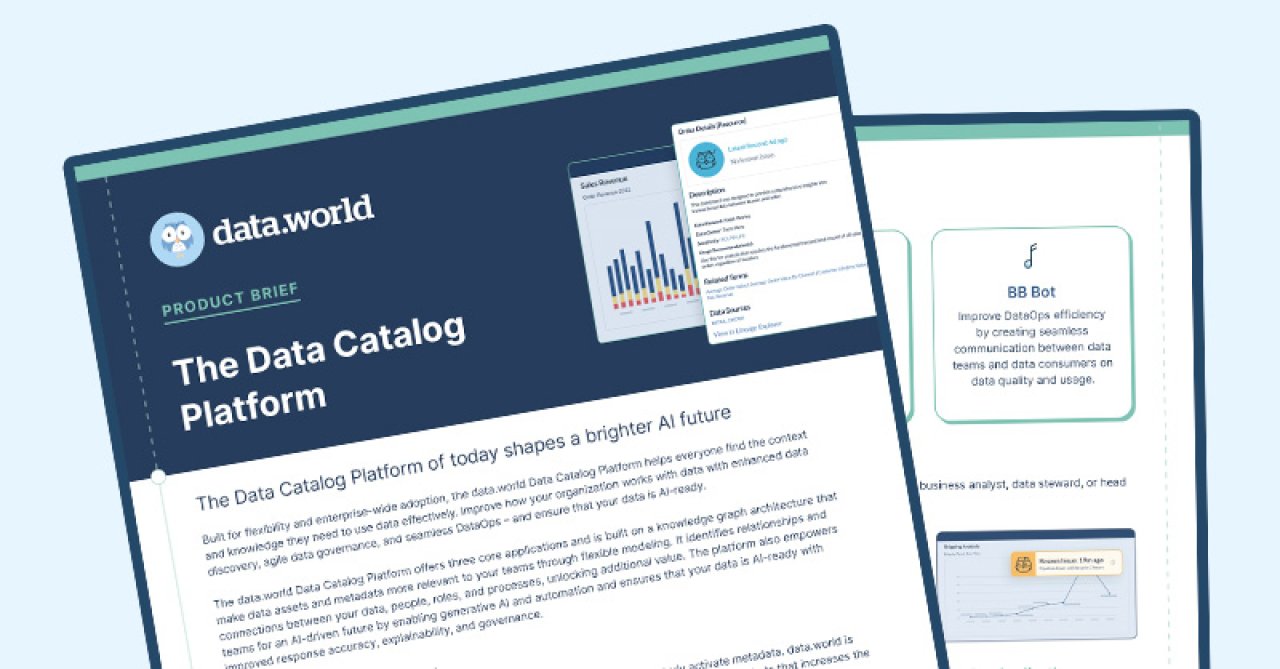







Sep 03, 2024

Jason Guarracino
Generative AI Product Leader

As artificial intelligence continues to evolve, the importance of robust knowledge representation becomes increasingly apparent, especially in the domain of generative AI. Among the various options available for knowledge representation, the Web Ontology Language (OWL) stands out as a superior choice. This article explores why OWL is particularly well-suited for generative AI applications, comparing it with other schema languages and illustrating its practical benefits across various domains.
The use of OWL in knowledge representation is not merely about creating ontologies—it's about enabling intelligent systems to understand and manipulate complex data structures effectively. As Juan Sequeda and Ora Lassila emphasize in Designing and Building Enterprise Knowledge Graphs, the goal is to integrate data and knowledge at scale, ensuring that real-world concepts and relationships are first-class citizens. OWL, with its formal semantics and reasoning capabilities, is a powerful tool in this endeavor.
OWL, a semantic web language designed to represent rich and complex knowledge, offers several key features that make it ideal for generative AI:
Formal semantics and multiple serialization
Support for properties, classes, individuals, and data values
Ability to define complex class expressions
Logical constructs for class axioms, property constraints, and individual assertions
Reasoning capabilities for consistency checking and inferencing
These features allow OWL to represent nuanced, context-dependent information crucial for generating accurate and relevant AI outputs. According to The Semantic Web for the Working Ontologist, "The Semantic Web doesn’t make data smart; it just gets the right data to the right place so the smart applications can do their work." OWL's role in this is to ensure that the data is structured and semantically rich, enabling intelligent applications to function effectively.
OWL's ability to define complex relationships and constraints is unparalleled. It allows for:
Complex class hierarchies and property relationships
Restrictions on properties (e.g., cardinality, value constraints)
Equivalent classes and properties
Disjoint classes and properties
Inverse, symmetric, and transitive properties
This expressiveness enables precise representation of domain knowledge, which is crucial for accurate AI reasoning and generation. As Sequeda and Lassila point out, understanding how data is logically structured and what it means is essential for accessing and using that data effectively. OWL provides the framework to create these logical structures, making it easier to build intelligent systems that can reason over complex datasets.
OWL's built-in reasoning capabilities offer significant advantages:
Automated inference and knowledge discovery
Consistency checking and error detection
Validation of instance data against class definitions
Identification of unintended inferences
These capabilities allow AI systems to work with both explicit and implicit knowledge, enhancing their problem-solving and generative abilities. The importance of inference is highlighted in The Semantic Web for the Working Ontologist, where the authors note that "inference is key" to the success of semantic applications. OWL’s reasoning features ensure that generative AI systems can draw new conclusions from existing data, making them more robust and versatile.
OWL supports the capture of nuanced domain knowledge and context-aware AI generation:
Precise definition of domain-specific concepts and relationships
Representation of complex hierarchies and partonomies
Capturing of contextual and situational knowledge
Expression of domain rules and constraints
This semantic richness enables AI systems to work with highly specialized knowledge across various domains, leading to more accurate, relevant, and nuanced outputs. As Sequeda and Lassila explain, "Knowledge graphs bridge the data-meaning gap" by connecting business terminology with underlying data structures. OWL, as a core technology in semantic web standards, plays a crucial role in building these connections, ensuring that the AI systems can interpret and generate content that aligns with the domain-specific knowledge.
As a W3C standard, OWL offers:
Wide adoption and support across various tools and platforms
Consistent syntax and semantics for knowledge representation
Regular updates and improvements to the language specification
Integration with other semantic web technologies (RDF, RDFS, SPARQL)
This standardization ensures long-term viability and compatibility for OWL-based AI systems, a point emphasized by both Sequeda and Lassila, as well as Allemang and Hendler. The use of standardized technologies like OWL is crucial for building systems that are not only effective today but also adaptable and scalable in the future.
To illustrate OWL's advantages, let's compare it with YAML in representing pharmaceutical knowledge:
medications:
- id: med1
name: Lisinopril
drug_class: ACE_inhibitor
treats:
- hypertension
- heart_failure
side_effects:
- dry_cough
- dizziness
contraindications:
- pregnancy
- angioedema_history
patients:
- id: patient1
name: John Doe
conditions:
- hypertension
- diabetes
medications:
- Lisinopril
- Amlodipine @prefix rdf: .
@prefix owl: .
@prefix : .
:Medication rdf:type owl:Class .
:DrugClass rdf:type owl:Class .
:Condition rdf:type owl:Class .
:Patient rdf:type owl:Class .
:treats rdf:type owl:ObjectProperty .
:hasSideEffect rdf:type owl:ObjectProperty .
:hasContraindication rdf:type owl:ObjectProperty .
:takesMedication rdf:type owl:ObjectProperty .
:Lisinopril rdf:type :Medication ;
:treats :Hypertension, :HeartFailure ;
:hasSideEffect :DryCough, :Dizziness ;
:hasContraindication :Pregnancy, :AngioedemaHistory .
:JohnDoe rdf:type :Patient ;
:hasCondition :Hypertension, :Diabetes ;
:takesMedication :Lisinopril, :Amlodipine .
:ContraindicatedMedication rdf:type owl:Class ;
owl:equivalentClass [
rdf:type owl:Restriction ;
owl:onProperty :hasContraindication ;
owl:someValuesFrom [
rdf:type owl:Class ;
owl:intersectionOf (
:Condition
[ rdf:type owl:Restriction ;
owl:onProperty :hasCondition ;
owl:someValuesFrom owl:Thing
]
)
]
] .
[ rdf:type owl:Restriction ;
owl:onProperty :takesMedication ;
owl:allValuesFrom [
owl:intersectionOf (
:Patient
[ owl:onProperty :takesMedication ;
owl:someValuesFrom :DrugInteraction
]
)
]
] .Expressiveness: OWL allows for more complex relationships and constraints, crucial for representing intricate medical knowledge.
Reasoning: OWL supports automated inference, enabling the AI to deduce new information (e.g., potential drug interactions).
Semantic Richness: OWL captures nuanced relationships, allowing for more accurate context-aware generation of medical content.
Extensibility: OWL's structure makes it easier to integrate new medical discoveries without overhauling the entire knowledge base.
The versatility and power of OWL-based knowledge graphs enhance generative AI across various domains. Let's explore some practical applications that demonstrate the real-world impact of using OWL for AI solutions:
In complex healthcare environments, OWL-based systems can significantly improve patient care and interdepartmental coordination:
Represent intricate relationships between different medical specialties
Infer potential interactions between treatments proposed by various departments
Generate comprehensive, multidisciplinary patient care plans
This approach ensures that AI-generated recommendations take into account the full spectrum of a patient's medical needs, leading to more holistic and effective care.
OWL-powered AI can revolutionize the often time-consuming process of literature review:
Categorize and summarize relevant papers based on semantic relationships
Infer connections between different research areas
Generate literature review drafts with proper context and relevance
By automating this tedious task, researchers can focus more on analysis and innovation, accelerating the pace of scientific discovery.
In the critical area of pharmaceutical safety, OWL-based systems provide an essential safety net:
Represent complex drug interactions and contraindications
Infer potential risks based on a patient's complete medical profile
Generate warnings and suggestions for safer alternatives
This application not only enhances patient safety but also assists healthcare providers in making more informed decisions.
OWL can drive creativity and innovation in product development:
Represent complex relationships between product features, user preferences, and market trends
Infer novel combinations of features based on semantic relationships
Generate innovative product concepts with justifications based on market data
This approach can lead to more targeted and successful product launches, reducing time-to-market and development costs.
OWL-based systems can transform educational experiences by enabling truly personalized learning:
Represent complex relationships between educational concepts, learning styles, and student profiles
Infer optimal learning paths based on individual student progress
Generate personalized lesson plans and educational content at scale
This application demonstrates how OWL can help scale great ideas, making personalized education accessible to a broader audience.
While OWL offers significant advantages, there are challenges to address:
Complexity: Developing user-friendly interfaces for OWL-based knowledge graph construction
Computational Overhead: Optimizing reasoning performance for large-scale knowledge graphs
Integration: Incorporating OWL into existing AI architectures and workflows
Future research directions include:
Integration of OWL with neural-symbolic AI systems
Extensions to OWL for temporal and spatial reasoning
Exploring the role of OWL in achieving Artificial General Intelligence (AGI)
OWL's superior expressiveness, reasoning capabilities, semantic richness, and standardization make it an ideal choice for knowledge representation in generative AI systems. By leveraging OWL-based knowledge graphs, we can create AI solutions that are more accurate, context-aware, and capable of handling complex domains. The practical applications discussed demonstrate how OWL enhances AI's ability to aid human coordination, automate tedious tasks, provide essential safeguards, inspire innovation, and scale impactful ideas.
As we continue to push the boundaries of AI capabilities, OWL will play a crucial role in bridging the gap between human knowledge and machine intelligence, enabling the next generation of sophisticated, knowledge-driven AI applications. From healthcare to education, and from research to product development, OWL-powered generative AI has the potential to transform how we approach complex problems and drive innovation across industries.

As artificial intelligence continues to evolve, the importance of robust knowledge representation becomes increasingly apparent, especially in the domain of generative AI. Among the various options available for knowledge representation, the Web Ontology Language (OWL) stands out as a superior choice. This article explores why OWL is particularly well-suited for generative AI applications, comparing it with other schema languages and illustrating its practical benefits across various domains.
The use of OWL in knowledge representation is not merely about creating ontologies—it's about enabling intelligent systems to understand and manipulate complex data structures effectively. As Juan Sequeda and Ora Lassila emphasize in Designing and Building Enterprise Knowledge Graphs, the goal is to integrate data and knowledge at scale, ensuring that real-world concepts and relationships are first-class citizens. OWL, with its formal semantics and reasoning capabilities, is a powerful tool in this endeavor.
OWL, a semantic web language designed to represent rich and complex knowledge, offers several key features that make it ideal for generative AI:
Formal semantics and multiple serialization
Support for properties, classes, individuals, and data values
Ability to define complex class expressions
Logical constructs for class axioms, property constraints, and individual assertions
Reasoning capabilities for consistency checking and inferencing
These features allow OWL to represent nuanced, context-dependent information crucial for generating accurate and relevant AI outputs. According to The Semantic Web for the Working Ontologist, "The Semantic Web doesn’t make data smart; it just gets the right data to the right place so the smart applications can do their work." OWL's role in this is to ensure that the data is structured and semantically rich, enabling intelligent applications to function effectively.
OWL's ability to define complex relationships and constraints is unparalleled. It allows for:
Complex class hierarchies and property relationships
Restrictions on properties (e.g., cardinality, value constraints)
Equivalent classes and properties
Disjoint classes and properties
Inverse, symmetric, and transitive properties
This expressiveness enables precise representation of domain knowledge, which is crucial for accurate AI reasoning and generation. As Sequeda and Lassila point out, understanding how data is logically structured and what it means is essential for accessing and using that data effectively. OWL provides the framework to create these logical structures, making it easier to build intelligent systems that can reason over complex datasets.
OWL's built-in reasoning capabilities offer significant advantages:
Automated inference and knowledge discovery
Consistency checking and error detection
Validation of instance data against class definitions
Identification of unintended inferences
These capabilities allow AI systems to work with both explicit and implicit knowledge, enhancing their problem-solving and generative abilities. The importance of inference is highlighted in The Semantic Web for the Working Ontologist, where the authors note that "inference is key" to the success of semantic applications. OWL’s reasoning features ensure that generative AI systems can draw new conclusions from existing data, making them more robust and versatile.
OWL supports the capture of nuanced domain knowledge and context-aware AI generation:
Precise definition of domain-specific concepts and relationships
Representation of complex hierarchies and partonomies
Capturing of contextual and situational knowledge
Expression of domain rules and constraints
This semantic richness enables AI systems to work with highly specialized knowledge across various domains, leading to more accurate, relevant, and nuanced outputs. As Sequeda and Lassila explain, "Knowledge graphs bridge the data-meaning gap" by connecting business terminology with underlying data structures. OWL, as a core technology in semantic web standards, plays a crucial role in building these connections, ensuring that the AI systems can interpret and generate content that aligns with the domain-specific knowledge.
As a W3C standard, OWL offers:
Wide adoption and support across various tools and platforms
Consistent syntax and semantics for knowledge representation
Regular updates and improvements to the language specification
Integration with other semantic web technologies (RDF, RDFS, SPARQL)
This standardization ensures long-term viability and compatibility for OWL-based AI systems, a point emphasized by both Sequeda and Lassila, as well as Allemang and Hendler. The use of standardized technologies like OWL is crucial for building systems that are not only effective today but also adaptable and scalable in the future.
To illustrate OWL's advantages, let's compare it with YAML in representing pharmaceutical knowledge:
medications:
- id: med1
name: Lisinopril
drug_class: ACE_inhibitor
treats:
- hypertension
- heart_failure
side_effects:
- dry_cough
- dizziness
contraindications:
- pregnancy
- angioedema_history
patients:
- id: patient1
name: John Doe
conditions:
- hypertension
- diabetes
medications:
- Lisinopril
- Amlodipine @prefix rdf: .
@prefix owl: .
@prefix : .
:Medication rdf:type owl:Class .
:DrugClass rdf:type owl:Class .
:Condition rdf:type owl:Class .
:Patient rdf:type owl:Class .
:treats rdf:type owl:ObjectProperty .
:hasSideEffect rdf:type owl:ObjectProperty .
:hasContraindication rdf:type owl:ObjectProperty .
:takesMedication rdf:type owl:ObjectProperty .
:Lisinopril rdf:type :Medication ;
:treats :Hypertension, :HeartFailure ;
:hasSideEffect :DryCough, :Dizziness ;
:hasContraindication :Pregnancy, :AngioedemaHistory .
:JohnDoe rdf:type :Patient ;
:hasCondition :Hypertension, :Diabetes ;
:takesMedication :Lisinopril, :Amlodipine .
:ContraindicatedMedication rdf:type owl:Class ;
owl:equivalentClass [
rdf:type owl:Restriction ;
owl:onProperty :hasContraindication ;
owl:someValuesFrom [
rdf:type owl:Class ;
owl:intersectionOf (
:Condition
[ rdf:type owl:Restriction ;
owl:onProperty :hasCondition ;
owl:someValuesFrom owl:Thing
]
)
]
] .
[ rdf:type owl:Restriction ;
owl:onProperty :takesMedication ;
owl:allValuesFrom [
owl:intersectionOf (
:Patient
[ owl:onProperty :takesMedication ;
owl:someValuesFrom :DrugInteraction
]
)
]
] .Expressiveness: OWL allows for more complex relationships and constraints, crucial for representing intricate medical knowledge.
Reasoning: OWL supports automated inference, enabling the AI to deduce new information (e.g., potential drug interactions).
Semantic Richness: OWL captures nuanced relationships, allowing for more accurate context-aware generation of medical content.
Extensibility: OWL's structure makes it easier to integrate new medical discoveries without overhauling the entire knowledge base.
The versatility and power of OWL-based knowledge graphs enhance generative AI across various domains. Let's explore some practical applications that demonstrate the real-world impact of using OWL for AI solutions:
In complex healthcare environments, OWL-based systems can significantly improve patient care and interdepartmental coordination:
Represent intricate relationships between different medical specialties
Infer potential interactions between treatments proposed by various departments
Generate comprehensive, multidisciplinary patient care plans
This approach ensures that AI-generated recommendations take into account the full spectrum of a patient's medical needs, leading to more holistic and effective care.
OWL-powered AI can revolutionize the often time-consuming process of literature review:
Categorize and summarize relevant papers based on semantic relationships
Infer connections between different research areas
Generate literature review drafts with proper context and relevance
By automating this tedious task, researchers can focus more on analysis and innovation, accelerating the pace of scientific discovery.
In the critical area of pharmaceutical safety, OWL-based systems provide an essential safety net:
Represent complex drug interactions and contraindications
Infer potential risks based on a patient's complete medical profile
Generate warnings and suggestions for safer alternatives
This application not only enhances patient safety but also assists healthcare providers in making more informed decisions.
OWL can drive creativity and innovation in product development:
Represent complex relationships between product features, user preferences, and market trends
Infer novel combinations of features based on semantic relationships
Generate innovative product concepts with justifications based on market data
This approach can lead to more targeted and successful product launches, reducing time-to-market and development costs.
OWL-based systems can transform educational experiences by enabling truly personalized learning:
Represent complex relationships between educational concepts, learning styles, and student profiles
Infer optimal learning paths based on individual student progress
Generate personalized lesson plans and educational content at scale
This application demonstrates how OWL can help scale great ideas, making personalized education accessible to a broader audience.
While OWL offers significant advantages, there are challenges to address:
Complexity: Developing user-friendly interfaces for OWL-based knowledge graph construction
Computational Overhead: Optimizing reasoning performance for large-scale knowledge graphs
Integration: Incorporating OWL into existing AI architectures and workflows
Future research directions include:
Integration of OWL with neural-symbolic AI systems
Extensions to OWL for temporal and spatial reasoning
Exploring the role of OWL in achieving Artificial General Intelligence (AGI)
OWL's superior expressiveness, reasoning capabilities, semantic richness, and standardization make it an ideal choice for knowledge representation in generative AI systems. By leveraging OWL-based knowledge graphs, we can create AI solutions that are more accurate, context-aware, and capable of handling complex domains. The practical applications discussed demonstrate how OWL enhances AI's ability to aid human coordination, automate tedious tasks, provide essential safeguards, inspire innovation, and scale impactful ideas.
As we continue to push the boundaries of AI capabilities, OWL will play a crucial role in bridging the gap between human knowledge and machine intelligence, enabling the next generation of sophisticated, knowledge-driven AI applications. From healthcare to education, and from research to product development, OWL-powered generative AI has the potential to transform how we approach complex problems and drive innovation across industries.